Terrified of an app crash, security breach, or system outage? No wonder - a security breach alone costs $4.88 million per year. There are numerous other technical difficulties that can arise and force you to postpone the launch of a product, service, or offer that seems ready.
This is where business process testing, also known as end-to-end testing, comes into play. In this article, you will learn what E2E testing is, why it is essential, how to implement it effectively, and best practices to optimize your QA processes.
What is end-to-end testing?
End-to-end testing is a quality assurance process that verifies the functionality of software from start to finish. It ensures that all system components work together as expected under real-world conditions.
The primary goal of E2E testing is to simulate the user's journey from beginning to end, allowing engineers to uncover dependencies and potential failures across the system.
Principles of E2E testing
End-to-end testing verifies the entire application workflow, ensuring that all components function together as expected. Here are some core principles of end-to-end testing:
User-centric approach. Prioritize understanding and simulating real user scenarios to ensure that an application aligns with user expectations and behaves effectively in genuine use cases.
Realistic environment setup. Testing is conducted in an environment that closely mirrors the production setup. This includes using real databases, integrating third-party services, and replicating network configurations.
Automation wherever possible. Test automation tools are leveraged to carry out end-to-end tests efficiently and consistently. Automation streamlines the testing process, saving time and resources while ensuring thorough coverage.
Prioritize testing end-to-end workflows. The testing process focuses on identifying and validating the most critical business workflows that users typically perform.
Data integrity testing. It verifies that data is processed and displayed accurately throughout the entire workflow, which is crucial for maintaining reliability and user trust in the application.
Performance testing. Performance testing under load is conducted to evaluate how the application handles the demands during high traffic, simulating real-world usage conditions.
Cross-browser and device testing. This includes testing for mobile apps, tablet, and desktop environments to validate compatibility and ensure that the application delivers a uniform experience regardless of the device being used.
Maintainability. E2E tests are structured in a modular and maintainable way to facilitate easy updates as the application evolves.
Collectively, these principles lead to a well-tested, high-quality application that can be confidently launched, ultimately maximizing its potential for success in the market and fostering long-term user loyalty.
How end-to-end differs from other types of testing
Unlike other testing methods, such as unit testing or integration testing, which focus on specific parts of the application or the way those parts connect, E2E testing checks the whole workflow. It makes sure that all elements of the application work well together and that users have a smooth experience.
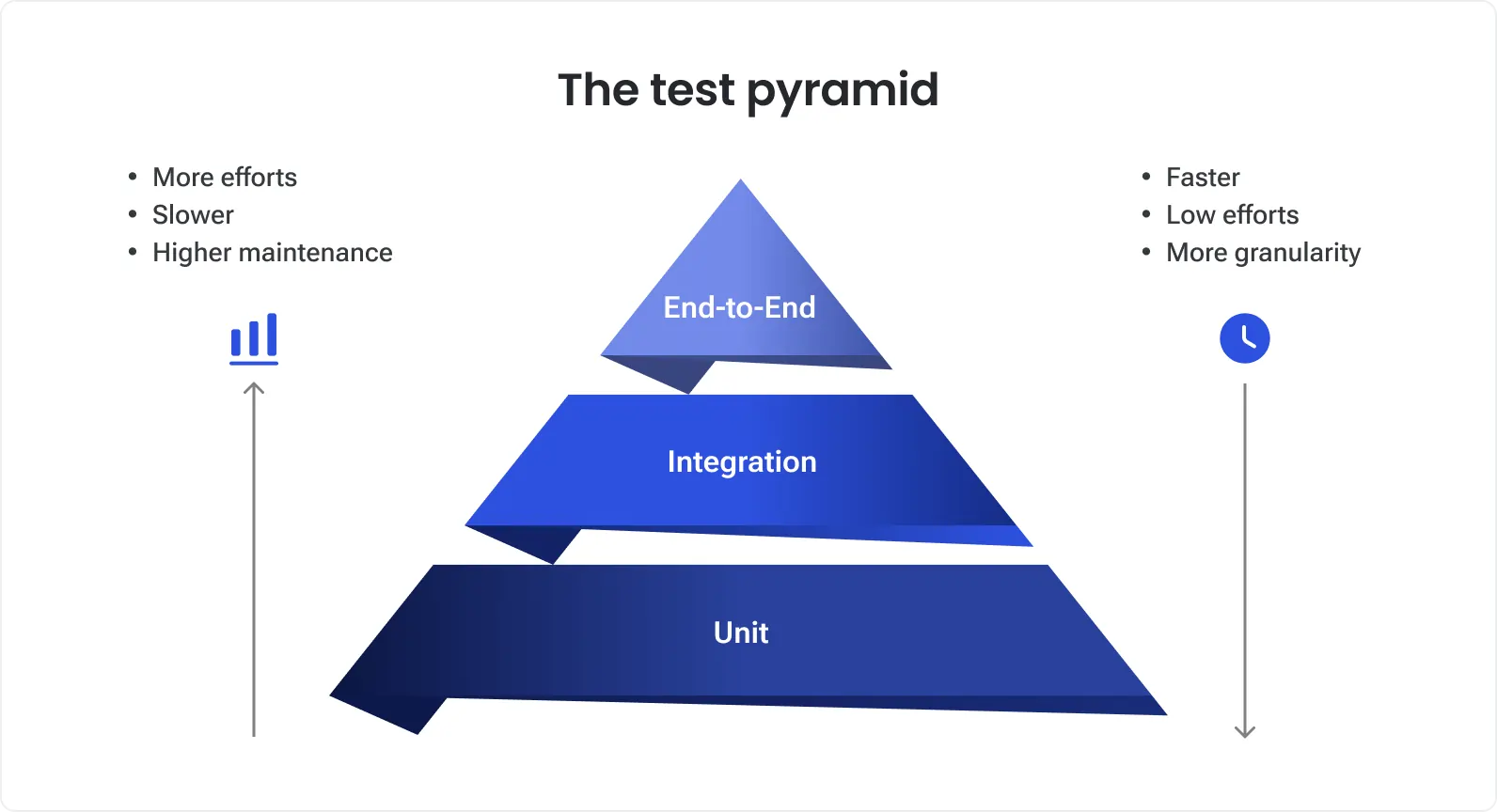
With understanding how E2E testing differs from other types of testing, teams can see its important role in ensuring that their applications are high-quality and meet the needs of users.
Definition
Testing individual components or functions in isolation.
Testing the interaction between integrated components or systems.
Testing the complete application flow from start to finish as a real user.
Purpose
To validate that each unit of the software performs as expected.
To identify interface defects and ensure that integrated components work together.
To ensure that the entire system works together as intended in a real-world scenario.
Level of Testing
Low-level testing (typically focuses on a single function or method).
Mid-level testing (tests interactions between components).
High-level testing (tests the collaboration of multiple components and systems).
Scope
Narrow (focuses on a single functionality).
Broader (focuses on the interaction of multiple units).
Comprehensive (covers all aspects of the application, including UI, backend, and external services).
Tools
Often uses mocking frameworks (Mockito (Java), Sinon (JavaScript), Moq (.NET).
Uses tools that can handle testing across component boundaries (e.g. Postman, Selenium).
Requires browser automation tools and testing frameworks (e.g. Cypress, Selenium, Playwright).
Speed
Fast, as it tests individual units and can run frequently.
Moderate, as it involves multiple components but is still relatively quick.
Slower, as it simulates user interactions and covers a large area of functionality.
Dependencies
Minimal, as it tests components in isolation.
Some, as it relies on other integrated components.
High, as it tests the application in a production-like environment.
Testers
Typically written by developers.
Typically written by both developers and testers.
Usually written by quality assurance teams or testers.
Frequency
Runs frequently in the development cycle (e.g. during CI/CD).
Runs less frequently, but validates after integration changes occur.
Runs periodically, often in large test cycles or before release.
Why end-to-end testing is critical for business
End-to-end testing is very important for a successful business. As modern applications rely on many different systems that work together. If proper end-to-end testing isn’t done, one small failure can lead to big problems, including downtime, loss of money, and unhappy customers.
Research supports this idea. A study from the University of Illinois found that at least 20% of serious problems in cloud applications come from issues between different systems. This number is even higher for open-source applications, with 37% of problems linked to these kinds of failures.
Prevents costly failures in production
According to the research, 26% of developer time is spent reproducing and fixing failing tests – which equals 620 million developer hours a year. The total value of salary spent on those hours adds up to $61 billion annually and equates to $1.2 trillion in enterprise value lost for shareholders a year.
E2E tests ensure that the whole system works together. By catching problems before the software goes live, companies can avoid expensive mistakes that could hurt their reputation and finances. A study found that fixing a bug after release can cost up to 30 times more than fixing it during development.
Identifies integration errors
E2E testing checks how different parts of the software work together. Sometimes, components that work well on their own can cause issues when combined. E2E tests help find these integration errors, ensuring smoother operation across the board.
Ensures cross-platform consistency
End-to-end testing is about making sure your application functions the same way on various devices and browsers. This type of testing is crucial because people might use your software on devices like smartphones, tablets, computers, and with different browsers. Ensuring everything works consistently allows businesses to provide a better experience, no matter how customers choose to use the product.
Enhances customer satisfaction and retention
According to Bain and Company, increasing customer retention rates by just 5% can increase profits by between 25% and 95%. When systems are stable and perform well, users are more likely to have a good experience. Great customer experiences lead to satisfied users who are more likely to return.
Types of end-to-end testing
End-to-end testing can be classified into different aspects of application verification and testing methodologies. Each type solves specific problems, providing full coverage of the application functionality and performance.
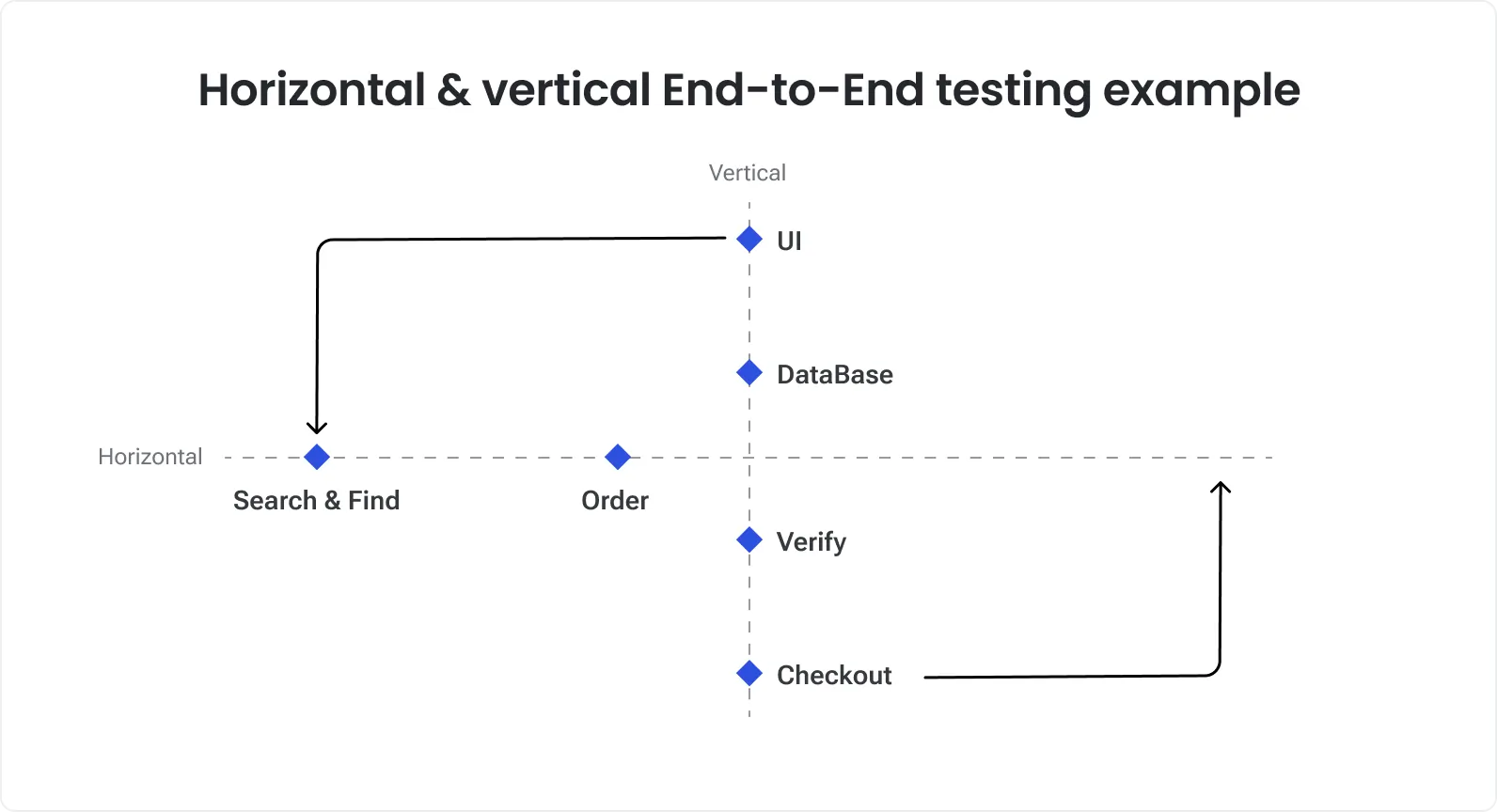
Horizontal E2E testing (User journey validation)
Horizontal end-to-end testing makes sure that the entire user experience in a software application runs smoothly from beginning to end. It simulates real user interactions to make sure every part and feature works well together.
In this type of testing, you concentrate on the complete journey a user takes through the system.
Horizontal E2E testing helps identify any breaks in the flow that may frustrate users. It ensures that the software meets user expectations and provides a smooth and enjoyable experience.
Vertical E2E testing (Technical layer validation)
Vertical end-to-end testing looks at the technical aspects of a software application, ensuring that these parts work well together. It digs into the system's structure to check that everything operates correctly across different areas, such as the user interface (what appears on the screen), services (the behind-the-scenes functions), databases (where data is stored), and integrations (how different parts connect).
The aim of vertical E2E testing is to ensure each technical component functions properly, both individually and when interacting with other parts. This might involve checking:
Database interactions: Verifying that data is correctly retrieved from and written to the database.
API calls: Automation checks the response from APIs that connect different parts of the application, ensuring they respond correctly and timely.
UI and backend linkage: Confirming that actions performed in the user interface trigger the expected backend processes, such as user authentication and data processing.
Vertical E2E testing is crucial for maintaining the reliability and performance of the software at a technical level. It ensures that all technical components function as intended and can handle the expected load, leading to a more robust application overall.
Manual vs. automated E2E testing: choosing the right approach
Companies often face the choice between manual and automated testing. Each approach has its pros and cons, so it's important to evaluate the company's needs and goals before deciding.
Given the fact that automation is very popular these days, companies employ it for testing purposes as well. Moreover, 24% of companies invested in test automation agreed that their ROI was “immediate.” Automating E2E tests involves using tools and frameworks to run tests without human intervention.
However, while automation offers many benefits, a mere 5% of companies engage in fully automated testing. Two-thirds of software development companies use testing in a ratio of either 75:25 (manual to automation) or 50:50. Only 9% of survey respondents rely exclusively on manual testing. Looking to the future, up to 73% of companies plan to achieve a testing balance of either 50:50 or 25:75.
Choosing between manual, automated or hybrid E2E testing is not a simple decision, as there is no standard answer which approach is the best for your specific business. By understanding the pros and cons of each method, as well as considering a hybrid approach, businesses can optimize their software testing strategy to meet their unique needs. The right combination will help ensure high-quality software that delivers a great user experience while remaining efficient and scalable.
How to implement end-to-end testing
Getting started with end-to-end testing services can feel overwhelming, especially for companies new to automation. We have gathered a comprehensive roadmap for successfully implementing end-to-end testing in your company.
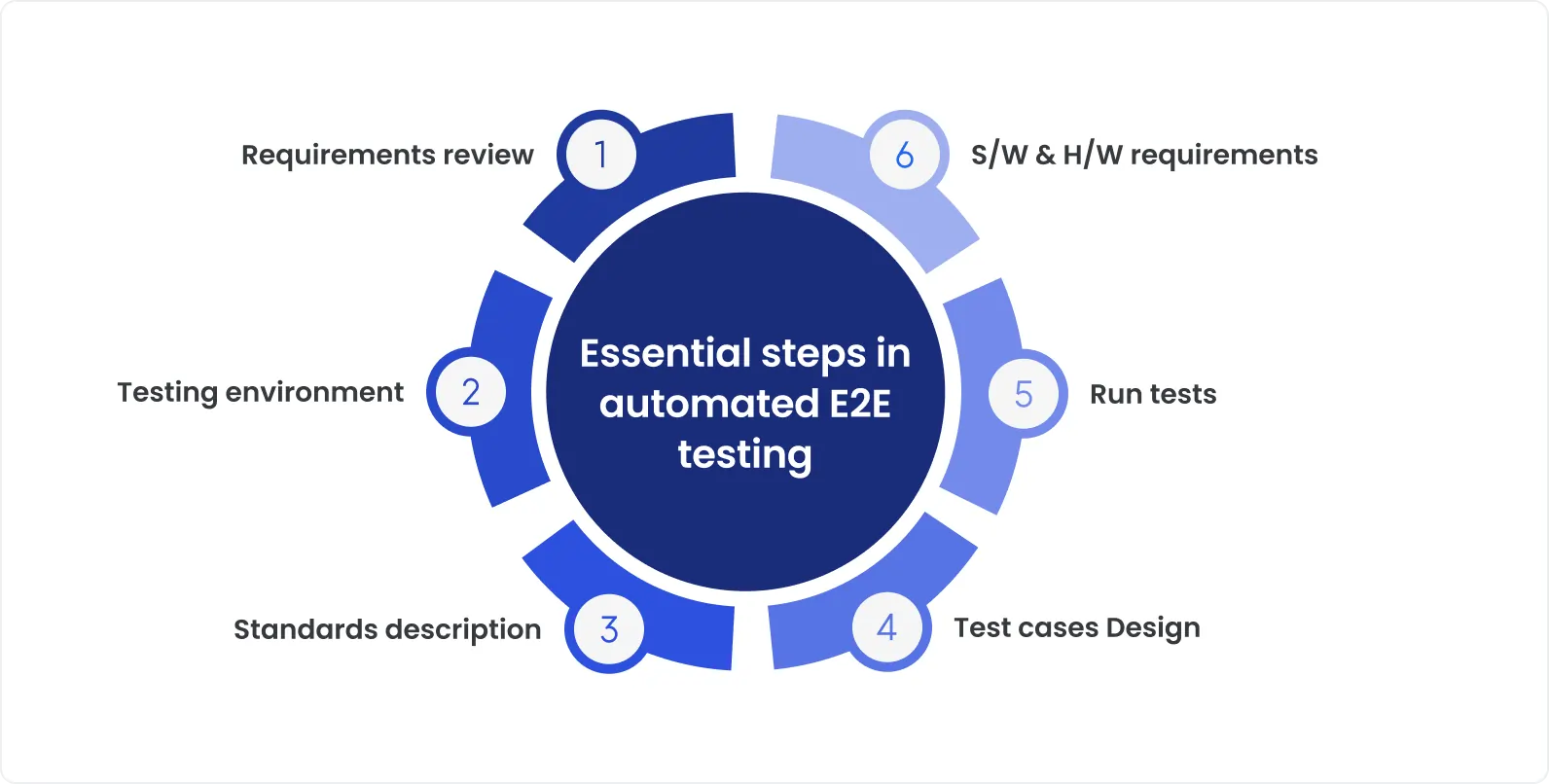
Planning and designing an effective E2E testing strategy
The first step is to clearly define the scope of your tests. This means identifying which parts of your application are most important for the business.
Next, it's essential to identify dependencies and edge cases. Dependencies refer to the different parts of your application that may rely on each other.
Creating robust end-to-end test cases is essential for ensuring that your application performs as expected in real-world conditions.
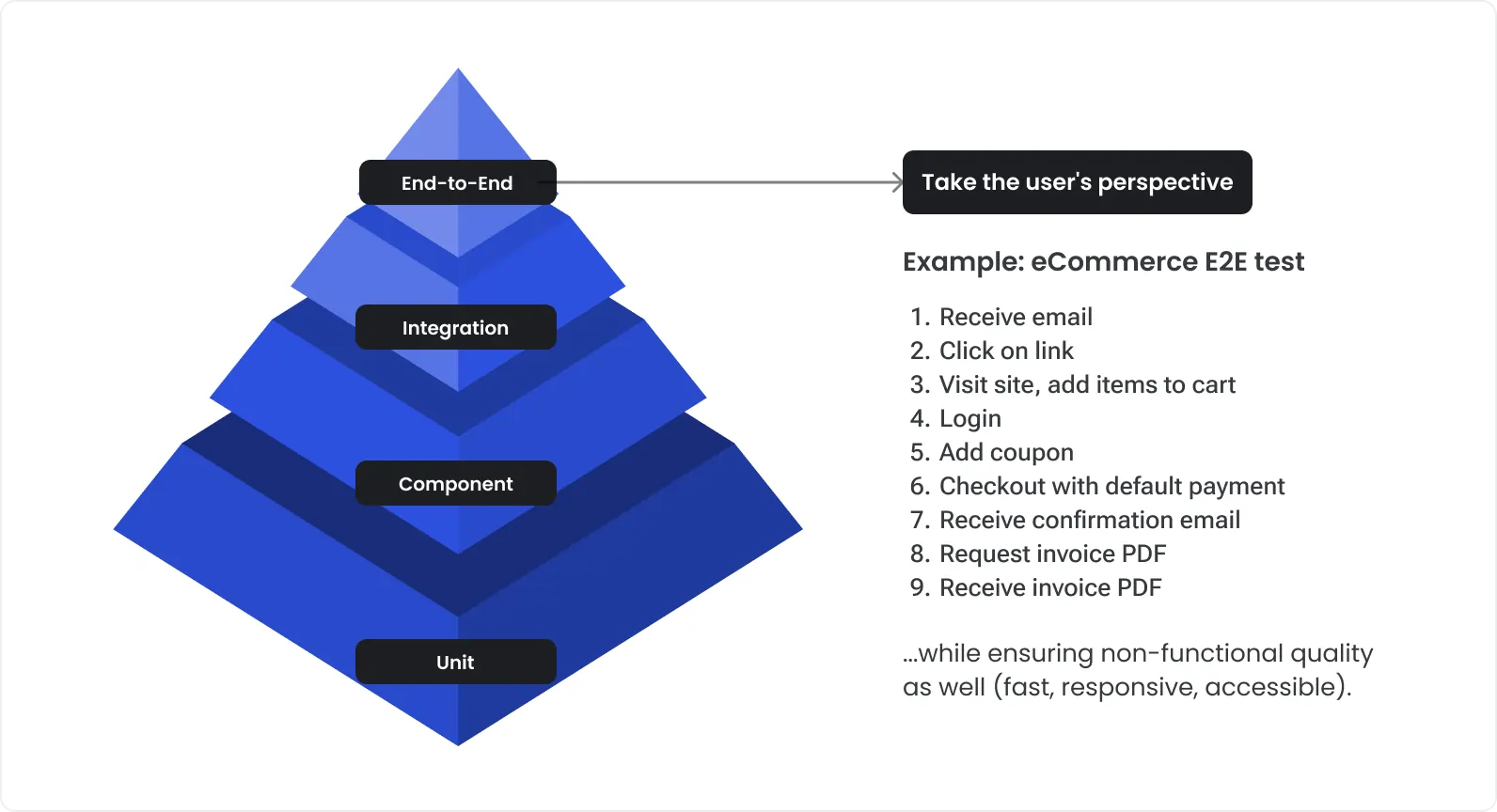
When designing test cases, it’s crucial to write scenarios that mirror how actual users will interact with your application. This ensures that your testing is realistic and thorough. Here are some strategies to achieve this:
Start by creating personas based on your target audience. Each persona will approach the application differently, and your test cases should reflect these varied interactions.
Identify common tasks users will perform. For a patient management system, test scenarios could include: A new patient signing up and completing their profile; an existing patient logging in to request medication refills; a doctor reviewing patient history and scheduling follow-up appointments.
Use data that closely resembles what users will encounter. For instance, if you’re testing an appointment scheduling feature, include test data with typical appointment durations, cancellation policies, and various patient scenarios (like repeat visits or missed appointments).
Automating E2E testing: tools and best practices
Automating end-to-end testing is crucial for improving test coverage and ensuring timely feedback on application quality. Using the right tools and practices will help streamline the testing process.
Choosing the right testing framework is vital for building effective and maintainable test automation. Below is a comparison of popular E2E testing frameworks:
JavaScript
Chrome, Firefox, Edge
- Fast and reliable testing
- Time-travel debugging
- Automatic waits and retries
- Easy setup and configuration
- Limited support for Internet Explorer
- Only supports JavaScript stack
- Does not support multi-tab or multi-domain testing by default
JavaScript, Python, Java, C#
Chrome, Firefox, WebKit, Edge
- Supports multiple browsers and devices
- Built-in support for network monitoring
- Great for testing mobile web applications
- Fast execution of tests across multiple browsers
- Newer compared to Selenium, which may affect community support
- Requires more setup and configuration for certain features (e.g., mobile testing)
Multiple (Java, Python, C#, Ruby, etc.)
All major browsers
- Mature and widely used
- Extensive community and resources
- Cross-browser compatibility
- Slower than others due to WebDriver architecture
- More complex setup and maintenance
- Requires external tools for some advanced features (e.g., mobile testing)
Successful integration of test automation within CI/CD pipelines will enhance your development and release processes.
With the right frameworks that suit your team’s needs and integrating these automation processes into CI/CD pipelines, you can ensure thorough testing at every stage of development while facilitating faster and more reliable deployment cycles.
Challenges in E2E testing and how to overcome them
Implementing effective E2E tests comes with its set of challenges. Companies often face hurdles such as maintaining test stability, managing complex test environments, handling dynamic data, and ensuring adequate coverage across various user scenarios.
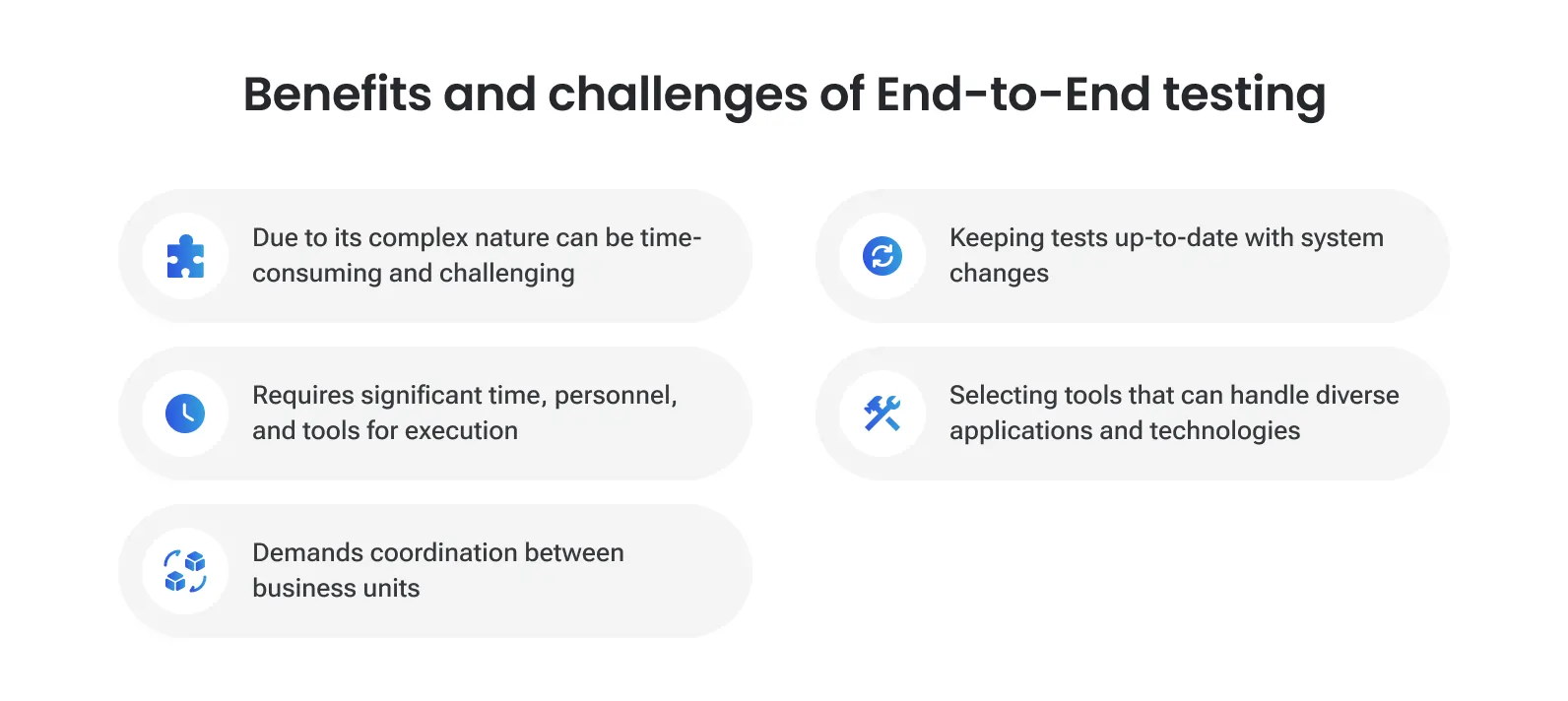
Flaky tests & false positives
Flaky tests and false positives are among the most frustrating problems in end-to-end testing. These issues can undermine confidence in automated testing, leading to more time spent diagnosing test failures than addressing actual defects in the application.
Flaky tests may pass or fail intermittently without any changes to the underlying codebase, while false positives report issues that don’t actually exist. Both scenarios can result in wasted resources, delayed releases, and ultimately a negative impact on software quality.
To mitigate these challenges, here are several effective strategies:
Identify and isolate flaky tests. Implement a robust logging system to identify patterns in test failures. Pay attention to tests that fail sporadically, and compile a report to help isolate the root causes.
Optimize test environment. Ensure that test environments accurately mirror production settings to avoid discrepancies that could lead to flakiness. Use fixtures to set up and tear down test data consistently.
Implement wait strategies. Replace hard-coded wait statements with explicit waits (like "WebDriverWait" in Selenium), which can help ensure that tests only proceed when a certain condition is met (e.g., an element is visible).
Reduce dependencies. Where possible, mock or stub external services and APIs that your application interacts with. Ensure tests use realistic and representative data sets.
Regular maintenance of test suites. Regularly review your test cases to remove or refactor tests that are consistently flaky or irrelevant due to changes in the application.
High maintenance costs
One of the pressing challenges in end-to-end testing is managing maintenance expenses while ensuring adequate test coverage. As applications evolve, so does the test code, which can lead to escalating maintenance efforts and expenses.
High volumes of tests can dilute focus and increase redundancy, creating a scenario where teams spend more time managing tests than validating their software. Striking the right balance between test coverage and test volume is critical to achieving efficient E2E testing without incurring prohibitive costs.
Prioritize critical user flows
- Focus on high-risk areas and critical user flows.
- Work with stakeholders to identify impactful features.
Implement test design techniques
- Create modular, reusable test components.
- Use parameterized tests to cover various scenarios without duplication.
Continuous test review and refactoring
- Schedule reviews to remove obsolete tests and realign with application changes.
- Use tools to identify redundant tests.
Leverage test automation wisely
- Automate tests that are stable and frequently executed; reserve manual testing for exploratory cases.
- Focus on critical E2E scenarios.
Invest in tooling and frameworks
- Utilize tools for insights on coverage and maintenance.
- Adopt frameworks that support easy writing and management of tests.
This strategic approach ensures that teams can maintain high-quality software delivery while keeping maintenance expenses in check.
Complex test data management
Effective test data management is a critical component of successful end-to-end testing, particularly when dealing with complex and dynamic datasets. Poorly managed test data can lead to unreliable test results, increased test execution times, and wasted resources due to false positives or negatives. Therefore, it is essential to implement strategies that facilitate efficient handling of dynamic datasets within the testing lifecycle.
Use test data generation tools
Utilize tools that can automatically generate test data based on specified criteria or templates. This ensures a consistent and repeatable dataset that can adapt to changing requirements. When using production data for testing, employ data masking to protect sensitive information while retaining the dataset's original structure and relationships.
Use data subsetting
Instead of using full production datasets, create subsets that capture the necessary characteristics for testing. This reduces the volume of data and speeds up test execution while maintaining relevance. Maintaining the ability to create dynamic subsets based on current testing requires ensuring that the data used remains relevant and up-to-date with the application’s evolution.
Implement data versioning
Establish a version control system for test data that allows tracking of changes and rollbacks if necessary. This ensures that the team can revert to stable datasets when application updates introduce issues. Regularly check that the test data versions align with the application logic, particularly after significant updates.
Integrate test data management into CI/CD pipelines
Incorporate automated test data refresh routines within continuous integration/continuous deployment (CI/CD) pipelines to ensure that tests always run with the latest data. Use parameterization in tests to dynamically pull relevant test data during execution, allowing for greater flexibility and adaptability.
Utilize data validation practices
Establish clear validation rules that define acceptable data formats, ranges, and consistencies. Automate the validation process to ensure data integrity before test execution. Conduct periodic audits of test data to confirm its accuracy and relevance to current testing scenarios.
Slow execution times
Testing is the primary source of delivery delays, and testing costs consume an average of 23%-35% of the overall IT spending. Slow execution times can significantly impact the efficiency of the software testing process, leading to delayed releases and increased costs. To address these challenges, leveraging parallelization and cloud testing strategies can dramatically improve test performance.
Parallelization. Split test suites into smaller, independent test cases that can be executed simultaneously across multiple threads or machines. Implement smart algorithms to determine which tests can run in parallel based on dependencies, enabling better resource utilization and faster feedback.
Cloud testing. Utilize cloud-based testing environments to dynamically allocate resources for increased computational power. Take advantage of different geographic cloud environments to run tests in diverse conditions and configurations, simulating real-world user experiences and accelerating testing cycles.
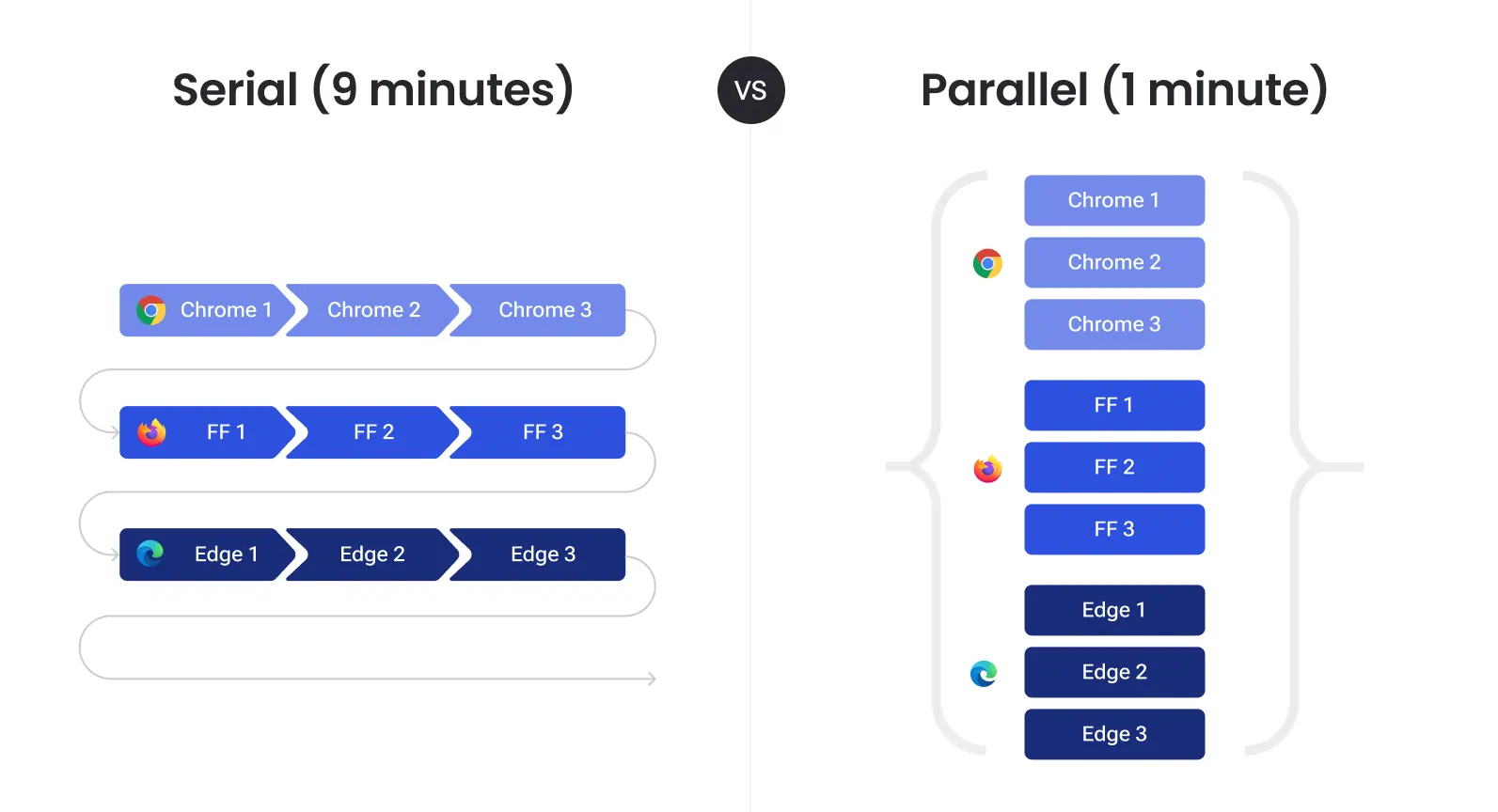
The combination of parallelization techniques with cloud testing platforms, companies can significantly cut down on execution times, facilitate faster release cycles, and ensure that their software quality remains high.
Key metrics for E2E testing results
Test coverage percentage
The percentage of requirements, features, or code paths tested.
Ensures critical functionalities are validated, reducing the risk of defects in production.
Defect escape rate
The percentage of defects discovered after release compared to those found in testing.
Indicates the effectiveness of the testing process; a lower rate suggests better quality assurance.
Mean time to detect (MTTD)
The average time taken to identify a defect after it has been introduced.
Reflects the efficiency of the testing process in catching issues early in the development cycle.
Mean time to repair (MTTR)
The average time required to fix a defect once it is detected.
Assesses the responsiveness of the development team; shorter MTTR leads to quicker releases and fewer disruptions.
Automation ROI
A measure of the return on investment for automated testing efforts, often calculated as benefits gained from automation versus costs incurred.
Helps justify automation initiatives by showcasing their value in terms of time savings and resource efficiency.
Test stability
The ratio of tests that pass consistently across multiple runs over time.
High stability indicates reliable tests, reducing flakiness and improving confidence in test results.
Best practices for E2E testing
When it comes to end-to-end testing, there are several best practices that can help ensure your tests are scalable and reliable.
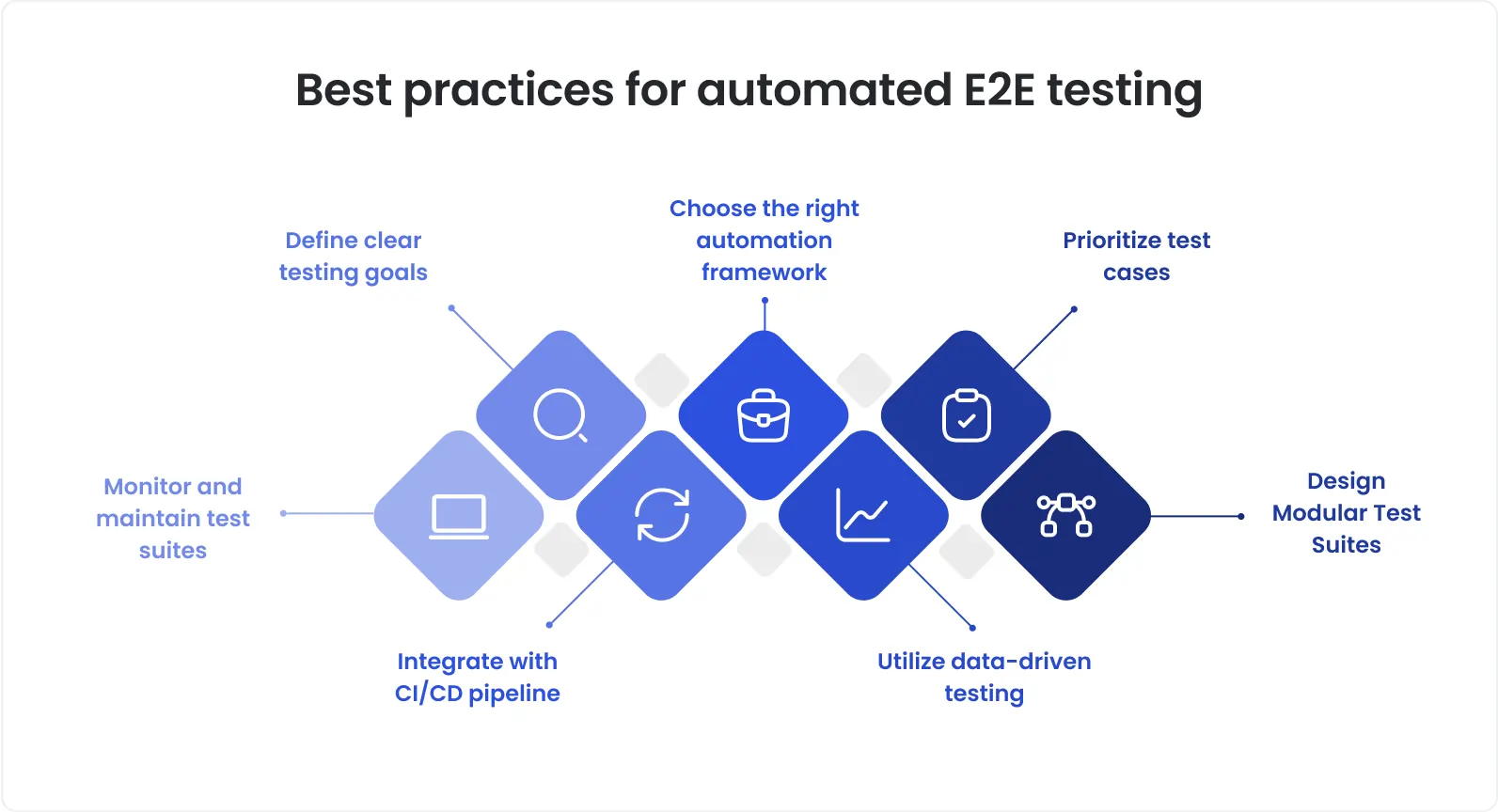
Focus on business-critical user flows
E2E testing involves testing the complete flow of an application from start to finish ensuring everything works as expected. By concentrating on business-critical user flows, you can prioritize the parts of your application that have the most impact on users and the business.
Prioritize API testing alongside UI automation
While UI automation is important for simulating user interactions, API testing is essential for checking the functionality of the application's backend. End-to-end testing vs. integration testing often arises in debates, but combining both approaches ensures that front-end and back-end work well individually and together.
You might automate a test that logs into your application via the UI, but it’s also helpful to ensure the login API works correctly by sending the same credentials directly through an API call. This way, you can identify issues faster.
Run tests in parallel for faster feedback loops
To make your E2E testing faster and more efficient, run tests in parallel instead of one after the other. This means that multiple tests can be executed at the same time, allowing for quicker identification of issues.
If you have a set of tests that check different user scenarios (like searching for a product, adding it to the cart, and proceeding to payment), executing them simultaneously can cut down the total testing time significantly – leading to rapid feedback for your development team.
Future of E2E testing: the role of AI and predictive analytics
With advancements in AI and predictive analytics, the way we approach E2E testing is poised for exciting changes.
AI-powered test generation and self-healing tests
One of the most significant innovations in E2E testing lies in AI-powered test generation. AI tools can automatically create test cases based on application behavior and user interactions, drastically reducing the time and effort required for manual test creation.
In a fintech application that allows users to manage their investments, the UI may change frequently based on user feedback and market trends. Instead of manually updating test scripts each time there’s a change in the layout or features, AI can analyze the application and adapt tests to reflect these updates. This results in self-healing tests, which can automatically adjust when a test fails due to a minor UI change, ensuring continuous and effective validation without significant manual intervention.
Continuous testing in DevOps and AI-assisted automation
As companies increasingly adopt DevOps solutions and practices, continuous testing becomes essential. AI can support AI-assisted automation, helping teams integrate testing into the development process seamlessly and ensuring that all components of an application are continuously validated.
Each new feature added for investment tracking or account management can trigger automated E2E tests powered by AI. If a defect is introduced, the AI can pinpoint the failing test case and suggest relevant code areas for investigation, greatly accelerating the feedback cycle for developers and improving the overall development workflow.
Conclusion
End-to-end testing helps catch problems before users encounter them, which is essential for providing a smooth and reliable experience. In a world where users expect everything to function perfectly, E2E testing acts as a safety net, helping companies maintain trust and satisfaction.
Contact DeviQA so you can focus on delivering excellent software that meets user expectations.
